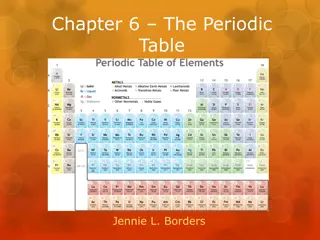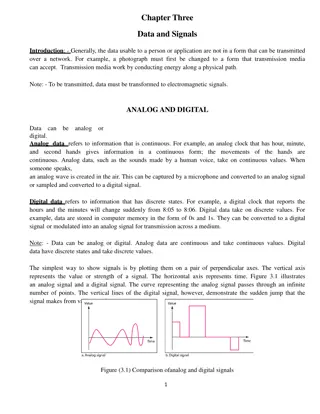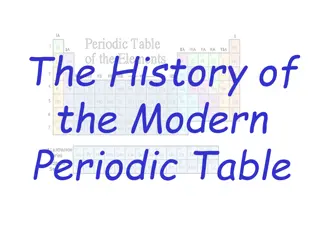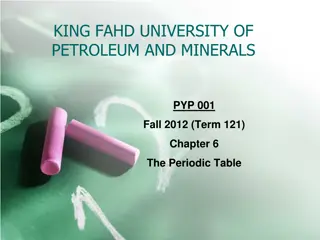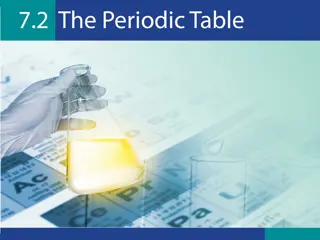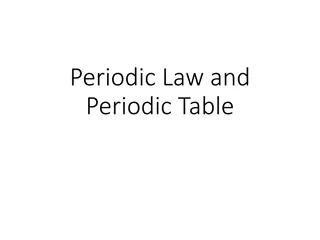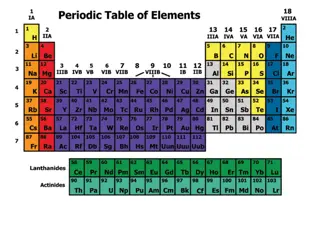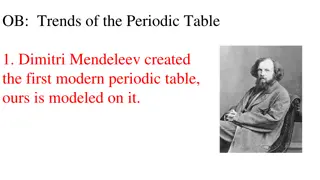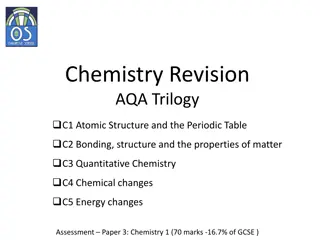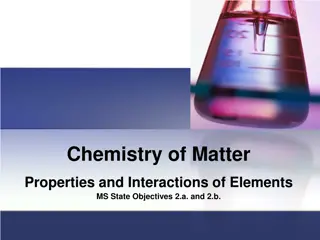Understanding the Evolution and Properties of the Periodic Table
Explore the history and organization of the periodic table, including changes over time, classifications of elements as metals, non-metals, and metalloids, and the formation of ions. Learn about key vocabulary, valence electrons, ionic trends, and various elemental properties like electronegativity and atomic radius. Delve into the contributions of chemists like John Newlands to the development of the periodic table.
Download Presentation

Please find below an Image/Link to download the presentation.
The content on the website is provided AS IS for your information and personal use only. It may not be sold, licensed, or shared on other websites without obtaining consent from the author. Download presentation by click this link. If you encounter any issues during the download, it is possible that the publisher has removed the file from their server.
E N D
Presentation Transcript
Structure and Properties of Matter Periodic Table Unit 1 - Lesson 7a-e
Periodic Table Learning Objectives: Describe how the layout of the periodic table has changed over time. Outline the arrangement of the modern periodic table, identifying the metals, non-metals and metalloids. Compare and contrast the properties of metal, non-metal and metalloids. Explain how the elements of the periodic table are organised Describe how valence electrons differ in periods and groups. Explain how ions are formed Use the periodic table to determine ionic trends. Use the periodic table to determine trends in electronegativity, electron affinity, atomic radius ionization energy, melting point and metallic character.
Periodic Table Key Vocabulary: Anion, Atomic radius, Brittle, Cation, Density, Ductile, Electrical conductor, Electron Affinity, Electronegativity, Group, Ionization Energy, Lustre, Malleable, Metal, Metallic Character, Metalloid/Semi-metal, Non-metal, Octet rule, Period, Semiconductor, Sonorous, Stability, Thermal conductor, Valency
Periodic Table The History of the Periodic Table Many of the elements we know today were originally discovered by the early chemists who worked to purify ores. In doing this, they realized that certain elements showed similarities in their properties and were, therefore, able to be grouped together. For example lithium (Li), sodium (Na), and potassium (K) were all shiny, conducted heat and electricity well, and reacted violently in water. The metals calcium (Ca), strontium (Sr), and barium (Ba), were also shiny, good conductors of heat and electricity, and had other similar properties. However, when the properties of the two groups were compared they were notably different from each other.
Periodic Table The History of the Periodic Table The non-metals, fluorine (F), chlorine (Cl), bromine (Br), and iodine (I) also exhibited similar properties to each other, but these properties were drastically different from those of any of the elements above. The periodic table has been rearranged by many chemists over time with the aim of showing the relationship between different elements.
Periodic Table John Newlands (pictured left), was one of the first to arrange the elements into a table using the order of increasing atomic weight in 1864. He observed that the properties of elements appeared to repeat themselves every eighth element and so grouped them accordingly. This, however, only worked for the first 17 elements. His attempts to force the other elements to obey this same pattern which he called the law of octaves failed miserably and so his theory was not accepted by other chemists of the time.
Periodic Table Dmitri Mendeleev (pictured right) in 1869 and Lothar Meyer in 1870 also recognized that there was a periodic relationship among the properties of the elements. He placed elements with similar properties in vertical groups and left gaps in the table for those that were yet to be identified and for those elements which did not seem to follow the same trend as other elements. Mendeleev s table is pictured on the next slide.
Periodic Table Mendeleev s Periodic Table: Attribution: Science and Society Picture Library, Dmitri Mendeleev (1871) [Public domain]
Periodic Table Mendeleev then used his table to predict the existence of elements that would have the properties similar to aluminium and silicon but still remained undiscovered. These elements were discovered less than two decades later - gallium (in 1875) and germanium (in 1886).
Periodic Table The Modern Periodic Table By the twentieth century, many other elements had been discovered and it had become apparent that some of the elements no longer belonged where they had been originally placed. In 1913, Henry Moseley, a member of Rutherford s research group discovered that each element had a unique number of protons. He found that certain lines in the X-ray spectrum of each element moved the same amount each time the atomic number was increased by one.
Periodic Table This information allowed the periodic table to be reordered according to atomic number, rather than the atomic weight (or relative atomic mass) of the elements. Atoms with similar properties were still placed together in the same vertical column with each element assigned to its own individual box. The box (pictured to the right) contained the elements: atomic number, symbol, relative atomic mass, and in some cases, its name.
Periodic Table The arrangement of the Periodic Table The periodic table also groups elements based on other attributes. Metals are generally found on the left-hand side of the table in groups 1-12 and some in groups 13-16. Almost all the non-metals (with the exception of hydrogen) are found on the right-hand side of the periodic table, mainly in groups 13-17 and all of group 18.
Periodic Table The image below shows the key areas of the periodic table:
Periodic Table Metals vs. Non-metals Most elements in the periodic table are metals and therefore have similar chemical and physical properties. The table on the next slide shows the properties of metals compared to non-metals.
Periodic Table Metals Physical Properties: Lustrous (is shiny) High density Usually solids at room temperature (except for mercury which is liquid) Melt and boil at very high temperatures Are ductile (can be drawn into thin wires) Malleable (able to be bent into shapes without breaking) Excellent conductors of heat and electricity Sonorous (make a deep ringing sound) Opaque as a thin sheet Non-Metals Physical properties: Dull Less dense, when compared to metals Can be solids, liquids or gases at room temperature Solids have lower melting and boiling points Poor conductors of heat and electricity Solids are brittle Non-sonorous Transparent as a thin sheet Chemical Properties: Corrode or oxidize in air or sea water React with acids to produce hydrogen gas. Readily lose electrons in a chemical reaction Chemical properties: Accept or share electrons in a chemical reaction.
Periodic Table Metalloids Elements which have both metallic and non-metallic properties are called metalloids or semi-metals, with many being an intermediate between a metal and a non-metal. Metalloids, such as silicon are frequently used as semiconductors and have the following properties: Can be either dull or shiny Usually conduct heat and electricity, although not as well as metals. Often make good semiconductors Often exist in several forms Often ductile Often malleable May gain or lose electrons in reactions
Periodic Table Electron Arrangements and the Periodic Table Elements of the periodic table are arranged in order of an increasing number of protons in the nucleus. Atoms with the same number of valence electrons are found in the same vertical column. Elements in the same horizontal row have the valence electrons in their atoms at the same energy level. Elements which are in the same horizontal row of the periodic table are said to be in the same period. Elements which are in the same vertical column are said to be in the same group. The groups are numbered 1 to 18.
Periodic Table Groups within the Periodic Table: For groups 1 and 2, and groups 13 to 18, the number of electrons can be determined as follows: Groups 1 and 2: The number of valence electrons = group number. For example, elements in group 2 have 2 valence electrons Groups 13 to 18: Number of valence electrons = group number - 10 For example, Group 17 elements have 17-10 = 7 electrons.
Periodic Table Valence Electrons across a Period: The number of valence electrons increases across a period. Elements in the same group have the same number of valence electrons but their valence electrons exist in different energy levels. The number of valence electrons increases across the second period is as follows: Element: Li Be B C N O F Ne Number of valence electrons: 1 2 3 4 5 6 7 8
Periodic Table Valence Electrons down a group The number of valence electrons remains the same down a group. Group 1 elements have one valence electron. Element Group Period Number of valence electrons 1 1 1 1 1 1 1 H Li Na K Rb Cs Fr 1 1 1 1 1 1 1 1 2 3 4 5 6 7
Periodic Table The Formation of Ions When atoms participate in chemical reactions they gain or lose electrons and form ions. This enables the atom to obtain a complete valence shell and increase its stability. Ions have an uneven number of protons and electrons causing them to lose their neutral charge and become either positive (denoted by a superscript number and a plus sign) or negative (denoted by a superscript number and a minus sign). The numbers are known as the valency and tell us about the ions overall charge. These numbers can be used to work out how many electrons the atom has in its ionic state.
Periodic Table There are two types of ions: Cations are positively charged ions which form when atoms (or groups of covalently bonded atoms) lose one or more electrons. Cations have fewer electrons than protons, giving them an overall positive charge. For example: When potassium (K) becomes an ion, it loses the lone electron from its outer shell. This means that there are still 19 protons, but only 18 electrons. This makes potassium in its ionic form K+1. Anions are negatively charged ions which form when an atom (or groups of atoms) gains one or more electrons. Anions have more electrons than protons which gives them their overall negative charge. These ions have the suffix ide. For example, fluorine becomes fluoride and oxygen, oxide.
Periodic Table Examples: Lithium metal has the atomic number 3, meaning that as an atom; it has three protons and three electrons, which gives it an overall charge of zero (i.e. neutral). Lithium has one electron in its valence shell which it loses when it participates in a chemical reaction. This means that it now has one more proton than it does electrons giving it an overall charge of positive one.
Periodic Table The seesaw image shows how the imbalance of charge in the protons and electrons gives lithium its positive one charge.
Periodic Table Oxygen has the atomic number 8, so it has eight protons and eight electrons, which gives it an overall charge of zero (i.e. neutral). Oxygen has six electrons in its valence shell so it gains two more when it participates in a chemical reaction, in order to fill this shell. This means that it now has two more electrons than it does protons giving it an overall charge of negative two. .
Periodic Table The seesaw image to the right shows how the imbalance of charge in the protons and electrons gives oxygen its minus two charge
Periodic Table Ionic trends in the periodic table The periodic table can be used to predict the type of ion an element will form, based on its location.
Periodic Table Other trends in the periodic table The arrangement of the periodic table provides us with important information regarding how an element will behave, based on its location on the table. Elements in the same groups will act in a similar fashion. The main periodic trends include: Atomic radius Ionization Energy Electronegativity Electron Affinity Melting point Metallic character
Periodic Table Atomic Radius Atomic radius is half the distance between the nuclei of two atoms (just in the same way that a radius is half the diameter of a circle). This distance is measured in picometers (1x10-12). Within a period or row of elements, the electrons are added to the same shell. However, protons are also being added to the nucleus, at the same time increasing the positive charge on the atom. As more protons are added to the nucleus, they provide a stronger positive attraction for the electrons around it. This results in them pulling the electrons shells closer to the nucleus, meaning that the valence electron(s) are held at much closer distances, which in turn, results in a decrease in radius from right to left across the period.
Periodic Table Atomic Radius With each subsequent group, the atomic radius increases since the electrons occupy higher energy levels. This results in the electrons being further away from the nucleus and the positive attraction from the protons is, therefore, less, so the electrons spread out further.
Periodic Table Ionization Energy Ionization energy is the energy required to remove an electron from a neutral atom in its gaseous state. The lower the ionization energy, the more readily an atom is able to lose one or more electrons and form a positive ion. Generally speaking, elements on the left-hand side of the periodic table (i.e. metals) have almost empty valence shells and lower ionization energies than those on the right-hand side, which is why they form positive ions. Elements on the right-hand side of the table have higher ionization energy as their valence shells are nearly full and are looking to gain electrons. Therefore, ionization energy increases from left to right on the periodic table. Noble gases have a very high level of ionization energy, due to their complete valence shells.
Periodic Table Ionization Energy Electron shielding also affects ionization energy. Electron shielding is the ability of an atom's core electrons to shield its positively-charged nucleus from its valence electrons. As we move to the right across a period, the number of electrons increases and so the strength of the shielding increases as well. This makes ionization easier, and so it decreases down a group.
Periodic Table Electronegativity Electronegativity measures an atom's ability to attract and bind with electrons and is based on its electronic configuration. Most atoms follow the octet rule, where the valence shell is comprised of 8 electrons. Elements on the left-hand side of the periodic table (i.e. metals) have less than half-full valence shells i.e. less than four electrons. Therefore, the energy required to gain electrons additional electrons to fill the shell is significantly higher compared to the energy required to lose the valence electrons. As a result, the elements on the left side of the periodic table generally lose electrons when forming bonds in a chemical reaction.
Periodic Table Electronegativity In contrast, it is more energy-efficient for elements on the right side of the periodic table (i.e. non-metals) to gain electrons to create a complete valence shell. Atoms which have a tendency to gain electrons to fill their valence shell are more electronegative than those which lose electrons. Therefore, electronegativity increases from left to right across the periods. By contrast, there is a decrease in electronegativity when descending down a group. This is because the atomic number increases down a group, as does the distance between the valence electrons and nucleus.
Periodic Table Electron Affinity Electron affinity is the ability of an atom to accept an electron. Unlike electronegativity, electron affinity is a measure of the change in energy that occurs when an electron is added to a neutral gas atom. In general, the more negative the electron affinity value, the higher an atom's affinity for electrons. Electron affinity increases from left to right across a period as the atomic radius becomes smaller and the forces of attraction become stronger. Therefore, the electrons to move closer to the nucleus. Electron affinity decreases down a group of elements because each atom is larger than the atom above it, and the electrons are further away from the positive pull of the nucleus.
Periodic Table Melting Point Trends The melting point of an element is the amount of energy required to break the bond(s), changing the element from a solid into a liquid. In general, the stronger the bond(s) between the atoms of an element, the more energy is required to break that bond. Elements on the periodic table have highly varied melting points and so there is no linear trend that is noticeable. However, the following generalised trends apply: Metals possess a high melting point. Most non-metals possess low melting points. The non-metal carbon has the highest melting point. The metalloid boron also possesses a high melting point.
Periodic Table Metallic Character The metallic character of an element is defined as how readily it loses an electron and forms a positive ion. Metallic character increases from right to left across a period, because the attraction between valence electron and the nucleus becomes increasingly weaker, making it easier to lose electrons. The metallic character also increases down a group because the size of the atom is increasing. When the atomic size increases, the outer shells are further away from the nucleus and the electrons in the valence shell are not held as tightly. This causes an increase in metallic character.




